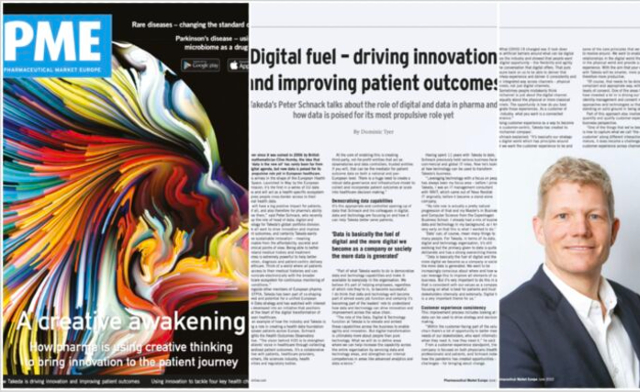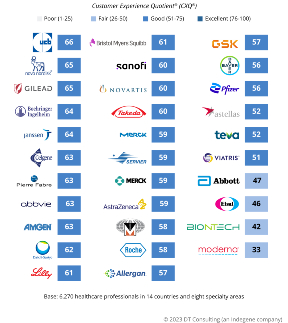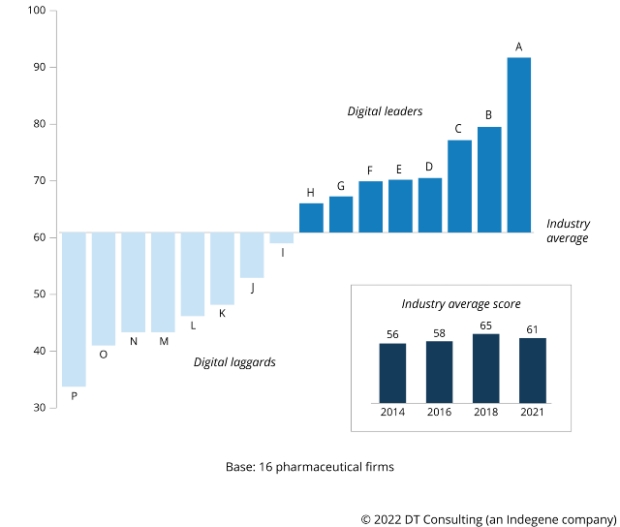Ever since it was coined in 2006 by British mathematician Clive Humby, the idea that ‘data is the new oil’ has rarely been far from the digital agenda, but now data is poised for its most propulsive role yet in European healthcare.
This arrives in the shape of the European Health Data Space. Launched in May by the European Commission, it’s the first in a series of EU data spaces and will act as a health-specific ecosystem that gives people cross-border access to their personal health data.
“It will have a big positive impact for patients, first of all, and also therefore for pharma’s ability to serve them,” says Peter Schnack, who recently took up the role of head of data, digital and technology for Takeda’s global portfolio division.
“We all want to drive innovation and improve patient outcomes, and certainly Takeda wants to drive sustainable innovation – meaning sustainable from the affordability, societal and economical points of view. Being able to better understand medical history and treatment outcomes is extremely powerful to help better prevention, diagnosis and patient centric delivery of healthcare. Think of a world where each patient has access to their medical history and can communicate electronically with the broader healthcare ecosystem for continuous monitoring of conditions”.
Alongside other members of European pharma body EFPIA, Takeda has been part of co-shaping the need and potential for a unified European Health Data strategy and has watched with interest as it’s developed into an initiative that positions data at the heart of the digital transformation of European healthcare.
As an example of how the industry and Takeda is playing a role in creating a health data foundation to empower patients across Europe Peter highlights the Health Outcomes Observatory initiative (www.health-outcomes-observatory.eu). “The vision behind H2O is to strengthen patients voice in healthcare through collecting standardised patients outcomes. It’s a collaborative initiative with patients, health care providers, researchers, life-sciences industry, health authorities and regulatory bodies. At the core of enabling this is creating third party, not-for-profit entities that act as observatories and data controllers, trusted entities if you will, that can be the mediator for patient outcome data on a national level and pan-European level. There is a huge to create a robust data governance and infrastructure model to collect and incorporate patient outcomes at scale into healthcare decision making.”
Democratising data capabilities
It’s this appropriate and controlled opening up of data that Peter and his colleagues in digital, data and technology are focusing on and how it can help Takeda better serve patients.
“Part of what Takeda wants to do is democratise data and technology capabilities and make it available to everybody in the organisation. We believe it’s part of helping employees, regardless of which role they’re in, to become successful. I do think that data and technology will become part of almost every job function and certainly it’s becoming part of the leaders’ role to understand how data and technology can drive innovation and improvement across the value chain.
“The role of the Data, Digital & Technology function at Takeda is to elevate and embed these capabilities across the business to enable agility and innovation. But digital transformation is ultimately more about people than pure technology. What we will do is define areas where we can help increase the capability across the entire organisation by servicing data and technology areas, and strengthen our internal competences in areas like advanced analytics and data science”.
Having spent 11 years with Takeda to date, Peter previously held various business-facing commercial and global IT roles. Now he’s looking at how technology can be used to transform Takeda’s business.
“Leveraging technology with a focus on people has always been my focus area – before I joined Takeda, I was an IT management consultant with NNIT, which came out of Novo Nordisk IT originally, before it became a standalone company.
“My role now is actually a pretty natural progression of that and my Master’s in Business and Computer Science from the Copenhagen Business School. I already had a mix between business, data and technology in my background, so I knew very early on this is what I wanted to do.”
‘Data’ can of course mean many things to many people. For Takeda, in terms of their data, digital and technology organisation, it’s still evolving but the primacy given to data is quite deliberate and has a strong overarching theme.
“Data is basically the fuel of digital and the more digital we become as a company or society the more data is generated. We want to be increasingly conscious about where and how we can leverage this to improve all elements of our business. But very important doing so in a manner which is consistent with our values as a company focusing on what is best for patients and trust with stakeholders internally and externally. Digital trust is a very important theme for us.”
Customer experience consistency
This improvement process includes looking at how data can be used to drive strategy and decision making.
“Within the customer facing part of the value chain there’s a lot of opportunity to better meet the needs of our stakeholders, who want information when they need it, how they need it” he says.
From a customer experience standpoint, the company is focused on both physicians (healthcare professionals) and patients and Peter notes how the pandemic has created opportunities – and challenges – for bringing about change.
“What COVID changed was it took down some artificial barriers around what can be digital across the industry and showed that people want the digital opportunity – the flexibility and agility in the conversation that digital offers. That puts pressure back on us to be able to deliver that seamless experience and deliver it consistently and in an integrated way across channels – and physical channels, not just digital channels.
“Sometimes people mistakenly think omnichannel is just about the digital channel. It’s equally about the physical or more classical channels. The opportunity is how do you best integrate those experiences. As a customer of any industry, what you want is a connected experience.”
Using customer experience as a way to become more customer-centric, Takeda has created its ‘omnichannel compass’.
Peter explains: “It’s basically our strategy for a digital world which has principles around how we want the customer experience to be and some of the core principles that we want this to revolve around. We want to enable the same relationships that you have in the physical world in the digital world and provide a connected experience. With the aim that your engagement with Takeda will be smarter, more personalised, and therefore more productive.
“Of course, that needs to be done in a compliant and appropriate way and with the right levels of consent. One of the areas that we have invested a lot in is to drive our ‘Takeda-ID’ identity management and consent management approaches and technologies so that we are standing on solid ground in being able to do that.”
Part of this approach also involves being able to quantify and qualify customer experience from a business perspective.
“One of the things that we’ve been maturing is how to capture what we call ‘the voice of the customer’ along different interaction points. As we mature it does become a challenge to measure the customer experience across channels and across services and then it’s also about making sure that everything we do actually generates some insight in terms of how we can continuously improve.
“We know Healthcare Professional (HCP) preferences have changed and we also know that preferences are different by country, by physician and by age. But whatever channel or medium you interact through, it all comes down to the value proposition and the service you bring to your customers and users, and I think data can help us inform that a lot.”
A business strategy for a digital world
Pharma has always been a data-driven business, of course. It’s inherent in need to prove clinical performance of a treatment and the consequent value it brings to patients. Areas like R&D and manufacturing were early to adopt data & digital innovation compared to other parts of the business.
“What is changing now is focusing on leveraging data and digital innovation across the lifecycle of the value chain,” according to Peter, who says the integration of data within pharma’s customer facing operations is still at an early stage. “In the commercial space and with our go-to-market models there’s still a lot to do – both for the industry and for Takeda.”
He adds: “Basically, we recognise that we want to leverage the power of data and technology, we want to drive digital transformation of Takeda broadly. In order to do that, it’s not just a technology transformation, it’s also, and probably more importantly now, a people and business driven transformation.
“The next step of driving this vision for Takeda is having a business strategy for a digital world. That’s why it’s important for it to be within the scope of business leaders and why we moved data, digital and technology resources and budgets from what used to be global IT & Digital to actually be within the business units themselves. We’re doing that to increase accountability, boost agility and to drive increased level of investments, because we do see that the investment in these capabilities most likely will more than double in Takeda within a couple of years.
“The opportunity for technology to improve healthcare and the digital health space is mind blowing,” he concludes.
• This article first appeared in the June 2022 issue of PME






